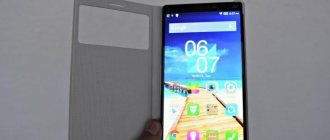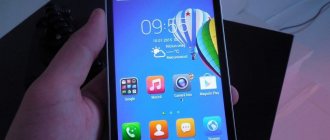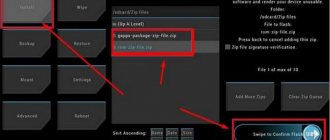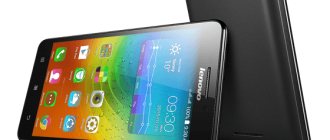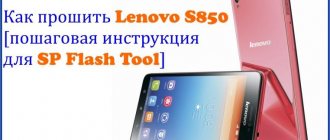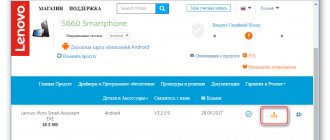Lenovo began its journey in the smartphone market by releasing models that focused on affordability. Today, having already become a prominent player, Lenovo is beginning to explore new opportunities to expand its share, gradually adding more expensive models to its smartphone portfolio. We received the Lenovo Vibe X2 for review, which the company tried to highlight not so much through its characteristics as through its unusual design. Let's see if Lenovo managed to create a smartphone that may be interesting not only in price and characteristics, but also in appearance.
[hl_line id=2866781]
Equipment
The smartphone comes in a box made in several colors, and even it tells us that what awaits us inside is not quite a simple phone. In order to open the box there is a special loop, pulling which opens access to the upper compartment.
It contains the device itself, paper documentation, a paper clip for opening the SIM card slot, a bumper made of transparent plastic and a protective film for the screen. The lower compartment contains a vacuum headset, a microUSB cable and a 1.5 A power supply. As you can see, the kit is more than good.
Detailed technical specifications
Make and model
Make and model of the device, and alternative names (if any).
| Brand Device manufacturer company. | Lenovo |
| Model Device name. | Vibe X2 |
Design
Appearance of the device including dimensions, weight, volume, colors and materials.
| Width The horizontal side of the device when used in standard orientation. | 68.6 mm (millimeters) |
| Height The vertical side of the device when used in standard orientation. | 140.2 mm (millimeters) |
| Thickness The cross-sectional size of the device. | 7.27 mm (millimeters) |
| Weight How much does the device weigh excluding the case, SIM and memory cards and other additional elements. | 120 g (grams) |
| Volume Approximate value calculated using the formula: length times width times height. | 69.92 cm³ (cubic centimeters) |
| Colors What colors is the device available in? | Red Gray Golden White |
| Housing materials What materials is the body made of? | Magnesium alloy Glass |
System on a Chip (SoC)
A system on a chip, a single-chip system (System on a Chip, SoC) is when several systems performing different device functions are connected on one chip.
| System on a Chip (SoC) A single-chip system that contains components such as a processor, graphics accelerator, memory units, communication interfaces, etc., as well as software for the operation of the system. | MediaTek MT6595M |
Central processing unit (CPU)
| Central processing unit (CPU) The main component of the device is responsible for calculations and data processing. | 4x 2.0 GHz ARM Cortex-A17, 4x 1.5 GHz ARM Cortex-A7 |
| Technical process What technological process is used to make the chip? The smaller the process technology, the better - the chips consume less power and generate less heat. | 28 nm (nanometers) |
| Processor size Processor capacity is a parameter that indicates how many bits of data a processor register processes in 1 clock cycle. This is usually 32 or 64 bits. | 32 bit |
| Instruction Set Architecture Instruction set architecture (ISA) is a programmable part of the microprocessor core used by software to control the operation of the processor. | ARMv7 |
| Number of processor cores The processor can be either single-core or multi-core. The performance of the processor depends on the number of cores (threads). The more cores working simultaneously, the higher the power consumption, so in mobile devices all cores are used only under high load. | 8 |
| CPU clock speed Clock speed is the number of operations per second that a processor or its core can achieve. The higher the frequency, the higher the overall performance of the device, but performance also depends on the processor architecture and the number of cores. | 2000 MHz (megahertz) |
Graphics Processing Unit (GPU)
| Graphics Processing Unit (GPU) The graphics processing unit (GPU) is used to process and display graphics - 3D effects, games, interfaces and other visual elements. Due to the pipeline architecture, the GPU is many times more efficient in graphics processing than the processor. | PowerVR 6200 |
| GPU clock speed Clock speed is the number of operations per second that the GPU or its core is capable of achieving. The higher the frequency, the higher the speed of the processor, and therefore the number of tasks it can solve. | 450 MHz (megahertz) |
Random access memory (RAM)
| Amount of random access memory (RAM) RAM (Random Access Memory, RAM, RAM) is temporary memory (works only while the device is running), which stores data and code for the operational operation of programs and applications. The more RAM, the more programs you can run simultaneously without loss of performance (there will be fewer “brakes”). | 2 GB (gigabytes) |
| Type of random access memory (RAM) Information about the type of RAM used by the device. | LPDDR3 |
| Number of RAM channels 1 is a single-channel RAM operating mode, basic, when 1 memory module is used. 2 is already a two-channel mode - a mode of parallel operation of 2 modules or pairs of modules, memory channels - this mode is 2 times faster than a single-channel one. 3 – three-channel mode is 3 times faster than single-channel mode. | Dual channel |
| RAM frequency The frequency of RAM determines the speed of RAM, or rather the speed of data transfer and reception. In theory, the higher the frequency, the more powerful the RAM. | 933 MHz (megahertz) |
Built-in memory
Most mobile devices have built-in Flash memory, which is used as a storage for system data, the operating system, as well as user data - photos, videos, recordings and much more.
| Built-in memory capacity The higher the amount of built-in memory, the more games, programs, music, videos and your other files will fit in the device, especially the amount of memory is important when the device does not support memory cards. | 32 GB (gigabytes) |
Operating system
A mobile operating system (OS) is pre-installed software with a well-thought-out interface for user control of device functions.
| Operating system (OS) The operating system installed by default by the device manufacturer, as well as its version. | Android 4.4.2 KitKat Android 5.0 Lollipop |
| User interface User interface (UI - user interface) is usually a graphical shell that ensures the transfer of information between the user and the operating system. | Vibe 2.0 |
Battery
To operate autonomously, a mobile device requires a battery that powers all its components.
| Battery capacity The main characteristic of a battery is its maximum capacity, that is, the charge it can store. Capacity is measured in mAh (mAh, milliamp-hour). The higher the capacity, the longer the mobile device can work. | 2300 mAh (milliamp-hours) |
| Battery type Many types of batteries have been used in portable devices, but NiCd (nickel-cadmium), NiMH (nickel-metal hydride), and even more so SLA (lead-acid) batteries are already considered obsolete. Instead, modern mobile devices use Li-Ion (lithium-ion) and Li-Pol, Li-Poly (lithium-polymer) batteries. | Li-polymer |
| Call duration on 2G network (GSM, CDMA) Approximately how long will it take for a fully charged battery to discharge when talking in 2G mode. Approximate, because this time is influenced by many factors, such as the operator, signal strength, active applications, and so on. | 17 h (hours) 1020 min (minutes) 0.7 days |
| Waiting time on 2G network (GSM, CDMA) Approximately how long will it take for a fully charged battery to discharge if the mobile device is not used and is connected in 2G mode. | 228 h (hours) 13680 min (minutes) 9.5 days |
| Call duration on 3G network (WCDMA, UMTS, CDMA2000) About how long a fully charged battery will be discharged during a call on third generation networks. Approximate time because it is influenced by various factors, including ambient temperature. | 19 h (hours) 1140 min (minutes) 0.8 days |
| Waiting time on 3G network (WCDMA, UMTS, CDMA2000) About how long a fully charged battery will be discharged if the mobile device is in standby mode and connected to third generation networks. | 216 h (hours) 12960 min (minutes) 9 days |
| Call duration on 4G (LTE) network How a long-charged battery will discharge during a conversation on 4G networks. Approximate time, since it is influenced by various reasons - the quality of communication with the tower, transmitter power, device firmware and much more. | 19 hours 30 minutes 19.5 hours (hours) 1170 minutes (minutes) 0.8 days |
| 4G (LTE) network latency How long will a mobile device last in standby mode when fully charged when connected to 4G networks. | 180 h (hours) 10800 min (minutes) 7.5 days |
Screen
The screen (display) is the main element for displaying graphic information.
| Technology The technology used to make the screen. There are many types of display manufacturing with their pros and cons. | IPS |
| Diagonal The screen diagonal of a device is measured in inches (inch, in or simply ″), and 1″ is equal to 2.54 cm. | 5 in (inches) 127 mm (millimeters) 12.7 cm (centimeters) |
| Width Approximate screen width | 62.26 mm (millimeters) 6.23 cm (centimeters) |
| Height Approximate screen height | 110.69 mm (millimeters) 11.07 cm (centimeters) |
| Aspect Ratio Aspect ratio is the ratio of the shorter side of the screen, which is considered to be 1, to the longer side, which is denoted by a decimal fraction indicating the ratio to the short side. | 1.778:1 16:9 |
| Screen resolution Screen resolution is the number of horizontal pixels (dots) multiplied by the number of vertical pixels. The higher the resolution, the more detailed the image will be. | 1080 x 1920 pixels |
| Pixel Density The number of pixels per inch or PPI (pixels per inch) indicates the density of pixels per 1 inch (2.54 cm) of the screen. The higher the PPI, the sharper the image, and the less visible or even invisible “squares and dots” (pixels). | 441 ppi (pixels per inch) 173 ppcm (pixels per centimeter) |
| Color depth Color depth means how many bits are used in 1 pixel to display color (bits per pixel). | 24 bit 16777216 colors |
| Screen area Approximate usable area occupied by the screen on the front of the device. The higher the percentage, the narrower the frames around the display or the smaller the “chin with bangs.” | 71.89% (percent) |
| Touch screen A touch screen is a device that usually covers the display and is a touch input tool. In fact, in mobile devices, the touchscreen is a replacement for the keyboard and mouse. | Yes |
| Touch screen type There are many types of touch screens, with their pros and cons. Mobile devices often use capacitive touchscreens, but technology does not stand still and new types of sensors are appearing. | Capacitive |
| Multi-touch Touch screen support for two or more touches. For example, zooming photos with two fingers. | Yes |
Main camera
The main camera, usually built into the rear of the device, is designed for creating photo and video content.
| Maximum image resolution This is the maximum number of pixels (dots) horizontally and vertically. The higher the resolution, the more detailed the image will be. Resolution can also be indicated in megapixels - this is the total number of pixels that can be in the image, calculated by the formula: vertical pixels multiplied by the number of horizontal pixels and divide the resulting amount by 1 million. | 4160 x 3120 pixels 12.98 MP (megapixels) |
| Matrix type There are two main types of photomatrix, CCD (Charge-Coupled Device) and CMOS (Complimentary Metal-Oxide Semiconductor). Mobile devices mainly use a CMOS matrix - it requires less space, has low power consumption and heating. Recently, new types of sensors have begun to appear, for example PureCel from OmniVision. | CMOS BSI (backside illumination) |
| ISO (light sensitivity) ISO is a standard that indicates a specific level of light sensitivity. The lower the ISO, the less sensitive the camera sensor is to light and the smoother the image is, with less noise. The higher the ISO, the correspondingly higher the light sensitivity, but more noise, graininess or reduced sharpness. The ISO range from 100 to 3200 is considered quite sufficient for everyday shooting in manual mode. | 100 — 1600 |
| Diaphragm Aperture (f-number, f) is used to control the light flux passing through the lens. The aperture is indicated by a fraction, and the smaller the fractional number, the higher the aperture passing through the lens. The more light that passes through the lens, the better overall, less noise in your photos and better night photography. | f/2.2 |
| Flash type Most mobile devices are equipped with light-emitting diode (LED) flashes, but there are also xenon flashes. As a flash, xenon is better - it is more powerful, but LED is more versatile (can work as a flashlight) and consumes less electricity. | LED |
| Maximum video resolution This is the maximum number of pixels (dots) horizontally and vertically. The higher the resolution, the more detailed the image will be. | 1920 x 1080 pixels 2.07 MP (megapixels) |
| FPS video recording at maximum resolution FPS (Frames per Second, frame rate) is the number of frames that changes in 1 second. The higher the number of frames per second, the smoother the image will be. In this case, we mean the number of frames that the camera can achieve at its maximum resolution; the lower the resolution, the higher the FPS can be. | 30 fps (frames per second) |
| Presence of flash Incorporating a flash into a mobile device allows you to take pictures in low light conditions. Creates the necessary lighting and compensates for the lack of natural light. | Yes |
| Digital zoom With digital zoom (zoom, enlargement), the subject is brought closer due to software image algorithms. The higher the magnification with digital zoom, the worse the image quality (noise, blur) will be compared to a non-zoomed one. | Yes |
| Number of lenses in the lens This is the number of optical elements (lenses) that are contained in the optical circuit of a camera lens. | 5 |
| Focus on face Function of auto-detection of living objects and autofocus on their face or head. | Yes |
| Panoramic shooting mode Panoramic photography is a series of frames where each subsequent frame is a continuation of the previous one; at the end of the shooting, all frames are stitched together at the software level to create a panoramic photograph. Frames can be shot both vertically and horizontally, and their width can be up to 360 degrees. This type of shooting is used when the camera's viewing angle is not enough to capture the entire scene. | Yes |
| HDR shooting mode HDR photography takes a quick series of shots with highlights, midtones, and shadows, then combines them into a single frame with high dynamic range. | Yes |
| Electronic (digital) image stabilizer EIS (Electronic Image Stabilizer - digital image stabilization) is performed using software algorithms and is needed to reduce blurring when the camera shakes. | Yes |
| White balance White balance is a setting that helps ensure the correct color reproduction in an image by determining the color temperature of the light source in the frame. The balance can be set either automatically or manually. | Yes |
| ISO Setting ISO is the level of light sensitivity. The lower the ISO, the less sensitive the camera's light sensor and the smoother the image with less noise. The higher the ISO, the higher the light sensitivity, but more noise, graininess, or decreased sharpness. | Yes |
| Additional Information Additional information about the functions and characteristics of cameras. | Autofocus Continuous Shooting Geo-tagging Touch Focus Exposure Compensation Scene Selection Mode |
Front-camera
The front camera of a mobile device (selfie camera, rear camera) is a camera on the front part, which is usually used for video communication, recognition of gestures or faces, and selfie photographs.
| Photo resolution The maximum image resolution that the camera can produce. As resolution increases, image detail increases. Resolution can also be indicated in megapixels (the total number of pixels that an image can consist of) - these are vertical pixels multiplied by horizontal pixels and divided by 1 million. | 2560 x 1920 pixels 4.92 MP (megapixels) |
| Diaphragm An aperture (or aperture) is essentially an adjustable baffle to control the amount of light passing through the lens. The aperture is indicated by a fraction, and the smaller it is, the more light passes through the lens, which has a positive effect on photographs - there will be less noise and better night photography. While the main cameras also come with an adjustable aperture, most front cameras have a fixed aperture. | f/2.4 |
| Video resolution This is the maximum resolution the camera can record video at. The higher the resolution, the better. | 1280 x 720 pixels 0.92 MP (megapixels) |
| Frame rate (FPS) of video shooting This is talking about FPS at maximum video resolution; at lower resolutions, the frame rate per second can be higher. FPS determines the smoothness of the video, as well as the ability to speed up or slow down it. | 30 fps (frames per second) |
SIM card
Subscriber Identification Module (SIM) used in mobile devices to identify subscribers in cellular networks.
| Type, size of SIM card A regular (mini SIM) card has dimensions of 25x15 mm. Micro SIM - 15x12 mm. Nano SIM - 12.3x8.8 mm. The sizes of SIM cards are different and not interchangeable. There is also an eSIM (virtual, electronic SIM card), it is built into the device and does not take up space. | Micro-SIM (3FF - third form factor, since 2003, 15.00 x 12.00 x 0.76 mm) Nano-SIM (4FF - fourth form factor, since 2012, 12.30 x 8.80 x 0.67 mm) |
| Number of SIM cards How many SIM cards does the device support? | 1 |
| Additionally Additional information about the operation of SIM cards in the device. | Dual SIM optional (A version of the model that has two slots for SIM cards.) |
Mobile networks
This is a system in which communication and data transfer is carried out between subscribers, the location of one or more of which changes. This section lists the supported mobile communication standards and frequencies.
| GSM GSM (Global System for Mobile Communications) is a standard for digital mobile cellular communications of the second generation 2G with time and frequency division of channels. GSM came to replace analog cellular communications 1G (first generation). | GSM 850 MHz GSM 900 MHz GSM 1800 MHz GSM 1900 MHz |
| TD-SCDMA TD-SCDMA (Time Division Synchronous Code Division Multiple Access) is a third generation (3G) mobile communications standard used in China. | TD-SCDMA 1880-1920 MHz TD-SCDMA 2010-2025 MHz |
| UMTS UMTS (Universal Mobile Telecommunications System), also called 3GSM, is a third generation (3G) mobile communications standard based on the WCDMA air interface. | UMTS 850 MHz UMTS 900 MHz UMTS 1700/2100 MHz UMTS 1900 MHz UMTS 2100 MHz |
| LTE LTE (Long-Term Evolution, often referred to as 4G LTE) is a standard for wireless high-speed data transmission, which, although it belongs to fourth generation networks (4G), is essentially a transitional stage from 3G to 4G, greatly accelerating data transfer speeds. The standard has an improved version, LTE Advanced (LTE-A), which can already be considered a full-fledged 4th generation network. | LTE 800 MHz LTE 1800 MHz LTE 2100 MHz LTE 2600 MHz LTE-TDD 1900 MHz (B39) LTE-TDD 2300 MHz (B40) LTE-TDD 2500 MHz (B41) |
Mobile network data standards
What data transfer standards in cellular networks are supported by the device, as well as their speed.
| Data transmission technologies Technologies for receiving and transmitting data, as well as their maximum speed. | UMTS (384 kbit/s) EDGE GPRS HSPA+ (HSDPA 42 Mbit/s) LTE Cat 4 (51.0 Mbit/s, 150.8 Mbit/s) |
WiFi
Wi-Fi (Wireless Fidelity) is a technology for wireless data transmission over a local network among devices based on IEEE 802.11 standards.
| Wi-Fi Hot-Spot A hotspot is a Wi-Fi access point. In a mobile device, Hot-Spot turns the smartphone into a Wi-Fi access point, essentially turning it into a router capable of distributing the Internet. | Yes |
| Dual-band Wi-Fi DUAL-BAND (dual-band) Wi-Fi is the ability of a device to immediately receive or broadcast wireless signals in two frequency bands 2.4 and 5 GHz. 5GHz is a less congested frequency, due to which the connection will be of better quality. | Yes |
| WiFi Supported WIFI wireless network standards. | 802.11a (IEEE 802.11a-1999) 802.11b (IEEE 802.11b-1999) 802.11g (IEEE 802.11g-2003) 802.11n (IEEE 802.11n-2009) 802.11ac (IEEE 802.11ac) |
Bluetooth
Bluetooth (BT, bluetooth (z), “blue tooth”) is a short-range wireless network (up to 10, sometimes 100 meters) operating on radio waves to transmit voice and data between devices.
| Bluetooth version Bluetooth technology is actively developing and, since 1998, has been constantly updating versions of the standard. Each subsequent version introduces one or several improvements in data exchange speed, range, facilitates pairing, reduces power consumption, or introduces some new protocols and operating profiles. The higher the Bluetooth version, the better. The technology is also backward compatible, for example, if your mobile device has version 5.0, then it will work with accessories version 4.2 and lower, but the improvements introduced in version 5.0 will not work; they will work only if both the device and accessories are version 5. | 4.1 |
| Bluetooth Low Energy (BLE) Bluetooth LE is a low energy BT protocol specification. | Yes |
| A2DP profile The A2DP Bluetooth profile is designed to transmit a high-quality two-channel stereo signal via Bluetooth to wireless headphones, speakers and other acoustics. | Yes |
Sensors
Modern devices have many sensors that help in measurements, trigger functions, and make using the device more pleasant.
| Light sensor The light sensor reacts to the light level and is able to adjust the screen brightness automatically based on this. This is necessary to reduce power consumption and ease of use of the device. | Yes |
| Proximity sensor The proximity sensor reacts to the proximity of the mobile device to some object. For example, the sensor is used when talking on the phone to turn off the screen, which saves energy and prevents you from pressing buttons with your ear or cheek. | Yes |
| Accelerometer An accelerometer is a sensor that measures apparent acceleration, that is, it determines the position and distance at which a mobile device moves in space. Based on the data from this sensor, the screen orientation change, pedometer, control using tilts and gestures in games and applications, etc. work. | Yes |
| Additional sensors |
Audio
Audio - characteristics and capabilities of a mobile device in terms of sound.
| Music speaker There are two types of speakers in mobile devices - auditory and musical. The auditory speaker (speaker) is used for conversation, the music speaker (buzzer) is used to play music and sounds. | Loudspeaker Earphone |
Radio
The radio in a mobile device can be built-in by the manufacturer (catch local radio channels, no internet required, often works only with headphones (as an antenna), but not always) or installed as an online application (requires internet, but more channels and often better quality) .
| Built-in radio Is a radio tuner integrated into the mobile device? | Yes |
Navigation and location
The location is determined by satellite navigation systems that track the device's autonomous geospatial location at multiple points. The most common satellite navigation systems are GPS, GLONASS, and the Chinese BeiDou.
| GPS GPS (Global Positioning System) is a global satellite navigation system that can determine the position of a mobile device, build routes and find the desired object on the map with an accuracy of several meters. | Yes |
| A-GPS A-GPS (Assisted GPS) is an assistive technology that will help you quickly find the location of your cellular device without waiting for satellite data, which is especially important in indoors and cities. Location is determined in various ways, for example, Wi-Fi access points, mobile towers, bluetooth and others. | Yes |
| GLONASS GLONASS is a Russian Global Navigation Satellite System, which is similar to GPS and works in tandem with it, increasing the accuracy and speed of navigation. | Yes |
| Additional navigation systems |
USB connector
USB (Universal Serial Bus) is a serial interface for connecting peripherals to computers, smartphones, laptops and much more. The interface allows you to exchange data and power a peripheral device with energy, as well as connect several peripheral devices to one USB connector at once.
| Connector type What type of USB connector is used in the device. | Micro USB |
| USB standard The higher the standard, the faster the throughput, or more precisely the data exchange rate. With version 3.0 of the standard, the current was increased to 0.9A, eliminating the need for additional power for some devices. | 2.0 |
| USB Mass Storage Connecting a mobile device via USB as a data storage device. That is, when you enable this mode, your device can be used as a flash drive. | Yes |
| Additional characteristics Additional features of the USB connector, for example, OTG, whether the connection is supported, peripheral devices and additional memory. | Charging via USB |
Headphone jack
A TRS headphone jack (or jack) is a common standard of connectors used for transmitting audio signals. By diameter there are jack (6.5 mm), mini-jack (3.5 mm) and micro-jack (2.5 mm). In mobile devices, the 3.5mm jack was considered the most popular and widespread, but recently they began to be removed, leaving only USB connectors, through which headphones are connected with a corresponding plug or using adapters.
| 3.5mm headphone jack Does the device have a 3.5 mm audio jack? | Yes |
Connection and synchronization
Options for synchronizing your mobile device and connecting it to other devices.
| Connection, synchronization Types of synchronization and connection technologies supported by the device. | Computer sync OTA sync Tethering |
Browser
A browser is a browser program for viewing sites and their content on the Internet. Through the browser, you can open websites, search for information, download necessary files, watch streaming videos, play browser games, etc.
| Technologies Markup and programming languages supported by the built-in (standard) browser. For mobile devices, you can install additional browser applications if the standard one does not suit you. | HTML HTML5 CSS 3 |
Audio file formats/codecs
Mobile devices support many audio file formats, as well as codecs for playing them.
| Default formats The formats that the mobile device supports out of the box are indicated. But if the device does not support the format you need, then you can try adding support for it. Sometimes support depends on the technical characteristics of the device (“hardware”) and nothing can be added here, but often the ability to process a particular audio format depends on the software part. You can install another audio player or codec set separately. | AAC (Advanced Audio Coding) AMR / AMR-NB / GSM-AMR (Adaptive Multi-Rate, .amr, .3ga) eAAC+ / aacPlus v2 / HE-AAC v2 MIDI MP3 (MPEG-2 Audio Layer II, .mp3) WMA (Windows Media Audio, .wma) WAV (Waveform Audio File Format, .wav, .wave) |
Video file formats/codecs
Video file formats that the device supports and is capable of decoding and playing.
| Default formats Video file formats that the device is capable of playing with standard firmware and a standard (built-in) set of programs. Not all formats are supported by default, but you can install a third-party video player and/or set of codecs. | 3GPP (3rd Generation Partnership Project, .3gp) AVI (Audio Video Interleaved, .avi) H.263 H.264 / MPEG-4 Part 10 / AVC video MP4 (MPEG-4 Part 14, .mp4, .m4a, .m4p , .m4b, .m4r, .m4v) Xvid |
Appearance and ease of use
The dimensions of the smartphone body cannot be called small, as it is equipped with a 5-inch screen. The dimensions of the device are 140.2x68.6x7.27 mm, and the weight is only 120 grams.
| Dimensions comparison | ||||
| Parameter/Device | Lenovo Vibe X2 | Samsung Galaxy S4 | LG Nexus 5 | Huawei P7 |
| Screen, diagonal | 5” | 5″ | 4,95″ | 5″ |
| Battery, mA*h | 2300 | 2600 | 2300 | 2500 |
| Length, mm | 140,2 | 136,6 | 137,8 | 139,8 |
| Width, mm | 68,6 | 69,8 | 69,2 | 68,8 |
| Thickness, mm | 7,27 | 7,9 | 8,6 | 6,5 |
| Weight, g | 120 | 130 | 130 | 124 |
The main feature of the smartphone is its multilayer body. That's where we'll start. When looking at the side panel in any color of the Vibe X2, a gradient consisting of three colors is clearly visible (not counting the dark display frame). This is what makes the appearance of the device unusual. It's worth noting that these are actually individual layers and not a painted solid plastic insert.
We received a gold color option for review, but it’s worth remembering that there are two more – red and white.
Otherwise, everything is familiar - the front side is covered with protective glass. At the top there is an earpiece, proximity and light sensors, a 5 MP front camera lens and a missed events LED. At the bottom are backlit hardware touch keys.
On the right side there is a volume control and power key, and on the left there is a slot for a SIM card in microSIM format. There is a 3.5 mm audio jack at the top, and a microphone and microUSB connector at the bottom.
On the back side there is a 13 MP main camera lens with a flash, an additional microphone, a manufacturer’s logo, a multimedia speaker and contacts for accessories.
Accessories include a removable battery, which doubles the capacity and adds only 5.1 mm to the thickness, and a two-channel JBL Hi-Fi speaker, which in turn increases the thickness by 8.3 mm, and connects to a smartphone via Bluetooth.
If we talk about workmanship, then in this regard the smartphone shows itself very well, not least because of the non-separable body. The only thing I didn't like was that the mechanical keys have some play. The smartphone came to us after several colleagues in the shop and this is very noticeable.
The screen, despite the use of protective glass, is already covered with small scratches, and the back side also does not look the same as on the new device, so for those who like to preserve the appearance of the device, it is worth using the included screen protection film and a transparent case.
The location of the mechanical keys is very convenient. Everything is located where you would expect to find it. The ease of use is affected by rather sharp corners, but this is all a matter of habit. After a few days you don’t notice any discomfort at all.
Design
The case consists of several layers, the boundaries of which are clearly visible, which is the calling card of this gadget. Each layer has a different color design. The buyer can choose between White, Black and Red versions of the smartphone. The phone is comfortable to hold in your hand. The front panel is covered with special protective glass.
On the front there is a front camera, a speaker and three touch buttons. At the back there is a main camera and flash. There is a headphone output at the top, and a microUSB output at the bottom.
On the right side there is a power button and a volume rocker. On the left side there is a slot for a microSIM card.
Hardware platform
Lenovo Vibe X2 is powered by an 8-core MediaTek MT6595m processor, which consists of four ARM Cortex-A17 cores clocked at 2.0 GHz and four ARM Cortex-A7 cores clocked at 1.5 GHz. As a result, we get a typical solution made using ARM big.LITTLE technology. It is worth noting that the index “m” at the end of the processor name indicates that this is the weakest configuration of the MT6595 processor, which is characterized by lower frequencies. The video adapter is PowerVR 6200 operating at 450 MHz. The RAM capacity is 2 GB, of which about 1.1 GB is available during normal use. The built-in memory is 32 GB, but the user has about 26 GB left and all of it is available for installing applications.
The competitor to this processor is Qualcomm Snapdragon 801 (8974AC). I agree that there is much more trust in Qualcomm processors, but benchmark results and real impressions of a device with a MediaTek MT6595 processor indicate that there is no reason for mistrust.
The device's performance is more than enough for smooth operation of the interface and launching demanding games. For example, the well-known game Real Racing 3 runs at maximum settings without any drop in fps. The rest of the games are also easy to launch, but it is worth considering that when using the smartphone for a long time under high loads, its body heats up.
Wi-Fi and GPS work without problems. Data transfer occurs as quickly as possible, and the speed of searching for satellites no longer raises any questions. The voice speaker quality is not the best. At maximum volume the sound becomes harsh and squeaky. But the sound quality of the multimedia speaker is quite good, but everything is spoiled by its location on the rear side. If you put the smartphone on the table, the speaker is completely blocked, which greatly muffles the sound, making it easy to miss a call. The vibration quality is good, but you shouldn't rely on it alone. Those who like to listen to music on headphones will appreciate the sound, because it is really good.
We were unable to check the support of video codecs by the built-in player using AnTuTu Video Tester, so we used the old method. As a result, we can conclude that the phone easily copes with all popular video codecs.
| Codec/Name | FinalDestination5.mp4 | Neudergimie.2.mkv | UltraHD4K.mp4 | Spartacus.mkv | ParallelUniverse.avi |
| Video | MPEG4 Video (H264) 1920×798 29.99fps | MPEG4 Video (H264) 1920×816 23.98fps | MPEG4 Video (H264) 3840×2160 29.92fps, 19.4 Mbit/s | MPEG4 Video (H264) 1280×720 29.97fps | MPEG4 Video (H264) 1280×536 24.00fps 2726kbps |
| Audio | AAC 48000Hz stereo 96kbps | MPEG Audio Layer 3 44100Hz stereo | AAC 44100Hz stereo 124kbps | Dolby AC3 44100Hz stereo | MPEG Audio Layer 3 44100Hz stereo 256kbps |
| Built-in Player | FinalDestination5.mp4 | Neudergimie.2.mkv | UltraHD4K.mp4 | Spartacus.mkv | ParallelUniverse.avi |
| Video | Yes | Yes | Yes | Yes | Yes |
| Audio | Yes | Yes | Yes | No | Yes |
Comparison with Vibe X2 Pro
To briefly describe the X2 Pro model, we can say that it is a slightly enlarged Vibe X2 with two 13 MP cameras, a Qualcomm Snapdragon 615 processor and a 5.3-inch display. The main differences between the models are presented in the table.
| Parameter | Vibe X2 | Vibe X2 Pro |
| Display | 5 inches | 5.3 inches |
| CPU | MediaTek MT6595M (2 GHz) | Qualcomm Snapdragon 615 (1.5 GHz) |
| Cameras | 13 MP main and 5 front | front and main cameras 13 MP each |
| Battery capacity | 2300 mAh | 2410 mAh |
| Memory card support | Absent | MicroSD support up to 128 GB |
| Weight | 120 g. | 140 g. |
| Price | from 12 thousand rubles | from 14 thousand rubles |
Conclusions:
Lenovo Vibe X2 and Vibe X2 Pro are very interesting representatives of the middle class.
They have an unusual design, a good display, and cool hardware. The only negative is low autonomy. If you choose between these two models, it is better to take the Pro, as you can expand the flash memory up to 128 GB using a microSD card. [taq_review]
Autonomy
The capacity of the built-in battery is only 2300 mAh. Despite this, with moderate use it can last a day with data transfer and automatic brightness turned on. If we limit ourselves to the basic capabilities, then we can count on two days of battery life with 4 hours of active screen and always-on data transfer. If this is not enough, then there is an “Emergency mode”, in which only calls and SMS messages are available. Naturally, if you use your smartphone to the maximum – play heavy games and watch videos – then be prepared to charge your device in the evening.
Communication capabilities
Lenovo VIBE X2 is equipped like its “big brother” Vibe Z2 Pro, namely: LTE, 3G, WLAN 802.11 b/g/n/ac, Bluetooth 4.0, NFC, USB 2.0, GPS, Glonass, AGPS. The Asian version of the smartphone supports 2 SIM cards. This, by the way, is a completely incomprehensible situation for us, and not only in the case of Lenovo. For example, LG releases its flagship G3 with 3GB RAM on board for Asia and the USA (LG G3 D851 version), and for Europe with 2GB RAM. Lenovo simply deprived Europeans of the ability to insert 2 SIM cards into their phones. And thanks for that...
Display
The smartphone is equipped with a 5-inch IPS screen with Full HD resolution. There is an oleophobic coating, making fingerprints easily erased. The pixel density is 441 per inch.
In sunny weather, the software's ability to increase brightness and contrast is a great help. Thanks to them, the information on the screen remains visible even in direct sunlight. The automatic brightness adjustment sensor behaves adequately, smoothly adjusting the brightness when it is really necessary, without increasing or decreasing it.
One of the features of the smartphone is advanced screen settings. In addition to the standard mode, there is also an adaptive mode, a high-brightness mode, a customizable and an advanced outdoor mode. In custom mode, you can adjust hue and saturation.
The results of screen measurements showed the following: the maximum screen brightness is 373 cd/m² in normal mode and 564 cd/m² in high-brightness mode, the minimum value is 5.3 cd/m² in normal mode and 13.7 cd/m² in increased brightness, display contrast is 1:792 in normal mode. As can be seen from the results, it is not surprising that even in sunny weather the information on the display is easily visible.
Checking the screen calibration shows us that the display's color gamut is significantly larger than sRGB. Green and red colors are shifted towards warmer shades. The color temperature graph really pleased with the minimal deviation from the reference value. This is extremely rare. But the gamma curve didn’t work out at all. The graph shows a significant jump.
The result is a very good, I would even say correct, display. It incorporates both the correct temperature and high brightness levels. For those who like to read at night, the screen will also not seem bright.
Performance
In terms of performance in Antutu, Lenovo VIBE X2 is ahead of the rest of the planet. It was not for nothing that they called him a monster. For this we can say the most powerful filling for a smartphone of this level - the eight-core Mediatek processor. Considering that the tests are carried out in FullHD resolution, the opponents for the hero of our review were selected accordingly.
The real games we used on the smartphone did not cause any complaints either: there was not the slightest hint of slowdown, everything was drawn clearly and quickly. Perhaps today this is a very successful multi-purpose gadget. Of course, after its 6-inch counterparts, the Lenovo VIBE X2 screen seems miniature, and the game graphics are small, but this is purely a consequence of habit. Let us repeat once again that in FullHD resolution everything works clearly and quickly!
Cameras
The smartphone is equipped with two cameras - a 5 MP front camera and a 13 MP main camera. The video recording capabilities are quite wide - the main camera records in Full HD resolution, and the front camera records in HD. If the front one is a completely ordinary camera with a fixed focal length, which is useful for selfie lovers or for communicating via Skype, then the main one is much more interesting. There are manual settings for contrast, saturation, sharpness, exposure and others.
The quality of the photos themselves is not the best, but good. In general, detail is smooth throughout the entire frame, and noise reduction works correctly. Even at night the pictures come out good. However, you can see this for yourself.
Example of pictures taken with the front camera:
Example of pictures taken with the main camera:
Video recording example:
Sound
The sound of the Lenovo VIBE X2 is quite good for its modest dimensions. We have to thank for this the speaker, which is located on the back of the smartphone. Of course, we are now talking about playing music and video soundtracks and, of course, about call volume. When you watch a video or listen to an audio file on the Lenovo VIBE X2, you get the feeling that the sounds are not coming from the phone, but from a larger device. Although, of course, for real sound lovers we recommend special gadgets.
As for the basic telephone functions, the speaker also pleases with clear, loud sound; interlocutors do not complain about distortion during a conversation.
User interface
The Lenovo Vibe X2 firmware is based on Android 4.4.2 complete with a lightweight Vibe 2.0 interface. As is often the case with Chinese phone makers, one can't help but notice its similarities to Apple's iOS. However, Lenovo's approach is clean and unobtrusive. Vibe 2.0 offers many additions to Android functionality without cluttering up the Lenovo Vibe X2's interface too much.
It’s logical to start the review with the lock screen. It is no different from the standard one and displays a date widget, up to four direct dial shortcuts, a camera icon and a messaging application. Lenovo replaced standard Android widgets with its own.
The desktop allows you to have up to 18 screens. That's a lot of space, but Lenovo doesn't have a separate app folder, so you might need more screens than usual. Each new installed program pops up on the desktop, just like in Xiaomi smartphones.
Apps can be grouped into folders that look like iOS 8 folders. A pinch on the desktop brings up a control screen where you can rearrange, remove, and add panels. Also here you can select the home page that will open when you press the Home button.
Calling up the menu on the home screen gives quick access to themes, desktop wallpaper, settings and manager. Here you can add and remove widgets.
The Theme Center allows you to change the appearance of the user interface. There are several built-in themes that change the wallpaper, loading animation, ringtones and application icons. You can also change the loading animation and lock screen style separately.
The notification area has a row of five user-selectable shortcuts, which can be expanded to 10 with a swipe down. Their order can be changed in the notification bar settings menu.
It should be noted that Lenovo did not enable Do Not Disturb mode. But there are four sound settings that allow you to quickly change the notification and ringtone.
The functions tab of the settings menu contains many interesting options. There are 3D gestures that allow you to remotely control the Lenovo Vibe X2 - answer or reject calls by swiping up or down on the display, and control playback. The micro-screen makes the interface more convenient for one hand, reducing its size. To enable it, you should draw the letter C from the top right corner.
A long press on the menu key brings up the application switcher. Swiping up on an app's icon removes it from memory and closes it. You can see the amount of RAM available, and there is a button to clear all open applications.
Wallpaper can be moved and replaced with a single swipe of your finger from the top right corner of the screen diagonally. Other settings include transition animation, restore and backup.
Adding widgets is not very convenient. You have to long press one of the four shortcuts at the bottom of the screen and then swipe up to open the widget panel. Then you need to select the required one and indicate the location of its installation.
Finally, the Google Now app integrates with your Google account and gives you access to everyday operations, web searches, email, and more.
It also provides information about traffic to your home or place of work, knows the results of matches of your favorite sports teams, and gives a weather forecast for your current location. It not only displays information on the screen, but can also process voice input.
Why you need to update the firmware on Android
The main point of updates is to eradicate bugs, problems and shortcomings, of which there are plenty in the Android operating system:
- For example, system applications freeze or crash.
- Blurred corners of pictures with a good camera.
- The smartphone does not turn on at all.
- The smartphone goes into an endless reboot.
- Heavy power consumption when wi-fi is turned on, for example, the battery runs out in an hour.
- There can be a lot of glitches; there are times when the phone itself starts calling the first number in the phone book. Hardly anyone is happy with this behavior.
There are also ordinary enthusiasts who love everything new and want to test the latest Android.

